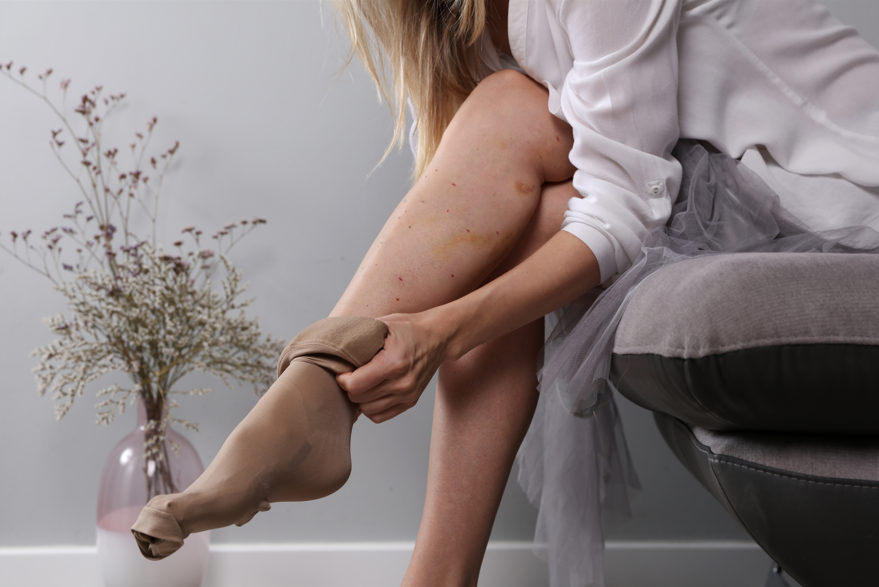Medically reviewed by Joanne Price DLT, MLDT & RMT.
What is Lipedema?
Lipedema is a chronic and progressive fat disorder, primarily affecting women. It causes a disproportionate accumulation of adipose tissue in the lower body – particularly in the hips, thighs, and legs – resulting in Lipedema pain, swelling, tenderness, and reduced mobility. Often triggered or worsened by hormonal events like puberty, pregnancy, or menopause, Lipedema is frequently misdiagnosed as obesity or Lymphedema.
Though there is currently no cure for Lipedema, conservative treatments like compression for Lipedema can help manage Lipedema symptoms and potentially slow the condition’s progression.
What are Compression Garments?
Compression garments are specially designed clothing that apply controlled pressure to specific areas of the body. While compression gear is widely used for sports recovery and poor circulation, compression garments for Lipedema are medically focused. These garments encourage healthy blood flow and lymphatic drainage, helping reduce swelling, pain, and tissue inflammation.
They come in various styles – leggings, stockings and sleeves – and compression levels, often measured in mmHg. Higher pressure (20–30 mmHg or more) typically requires a prescription and professional fitting. The flat knit compression garments I had to wear pre and post surgery had to be specially made and were measured by my Lymphedema nurse in the UK.
Compression for Lipedema
Compression therapy plays a key role in conservative management. It works by promoting the movement of fluid through the lymphatic system and reducing build-up in affected limbs in a similar way to Lipedema massage. With consistent use, compression for Lipedema can:
- Reduce pain and heaviness in the limbs
- Improve lymphatic drainage and circulation
- Be a component in trying to prevent secondary Lymphedema
- Provide support to loose connective tissue
- Help reshape the body and improve mobility
Medical-grade flat knit compression garments are typically used for Lipedema (especially in the latter stages), as they offer better support and customisation compared to circular knit types. However, in stages 1 and some stage 2 sufferers depending on limb shape, off the shelf circular knit or compression leggings from brands like TLC and Lipoelastic are highly effective.
Different Types of Compression for Lipedema
The type and level of compression you need depends on the stage of your Lipedema, your lifestyle, and whether you’re undergoing Lipedema Reduction Surgery.
Flat Knit Compression
Custom-made flat knit garments offer uniform compression, are more durable, and can be tailored to fit your unique shape. They’re especially important for stage 3 Lipedema or pre/post-operative care. Read all about it on my blog: ‘Lipedema Liposuction Pre Surgery Checklist.’
Off-the-Shelf Garments
Brands like Lipoelastic offer ready-to-wear options. While they don’t provide the same therapeutic pressure as flat knits, they’re a good alternative for people in the earlier stages, for gentle exercise for Lipedema or gym sessions when ‘full’ compression isn’t practical.
Arm Compression Garments
Though Lipedema most often affects the lower body, some women also experience Lipedema symptoms in the arms. In such cases, compression sleeves can be added to your routine for full-body support.
Getting Measured: Why It Matters
Proper fit is essential. Compression garments that are too loose won’t offer therapeutic benefits, while those that are too tight can restrict circulation and lymphatic flow causing discomfort.
Measurement should be done by a specialist – usually a Lymphedema nurse, vascular specialist or a private MLD Therapist known as a Decongestive Lymphatic Therapist – who will follow specific sizing charts provided by the manufacturer. If you change brands or notice any changes in your body, re-measuring is essential. Especially post surgery once the swelling has subsided.
Many UK-based services now offer postal prescription delivery, so once you’ve been measured, your garments can be delivered straight to your door. Some services even help with repeat prescriptions. I use Patient Choice for my compression garments and they’ve always provided a fantastic service.
Tips for Wearing Compression Garments
- Put them on first thing in the morning when swelling is minimal.
- Use tools like Arion Easy Slides or rubber gloves to help get garments on.
- Wear them daily – consistency is key for effectiveness.
- Replace them regularly, typically every 6 months depending on wear.
- Ease into it. Start with shorter periods if you’re new to compression and build up over time.
Compression for Surgery: Pre and Post-Op Requirements
If you’re preparing for Lipedema surgery, compression becomes even more important. Clinics like Lipemedical require patients to wear flat knit compression garments for 16 hours a day for at least 6-8 weeks before surgery. This helps soften fibrotic tissue and prepare the body for better surgical outcomes.
Post-surgery, the same garments are worn for another 8 weeks to support healing, reduce swelling, and shape the newly contoured limbs. Compression is vital for recovery to ensure you get the very best results post Lipedema Reduction Surgery.
My Personal Experience with Compression for Lipedema
Let’s be real – me and compression garments have a love-hate relationship. They take effort, and it’s easy to feel overwhelmed in the beginning. I booked my WAL liposuction surgery at the start of 2023 and had months to get used to wearing compression. Now it’s part of my daily routine.
In August 2023, I began wearing my flat knit garments daily. I was also introduced to a pair of sports compression leggings by Lipoelastic, which I now wear to the gym on days when my flat knits feel too restrictive. They aren’t medical grade, but they’re a helpful alternative when I need a break. Click here to view the Lipoelastic website.
So, Is Compression for Lipedema Worth It?
Absolutely! Compression isn’t just about comfort – it’s a proven method to reduce symptoms, protect your lymphatic health, and slow the progression of Lipedema. Whether you’re in early stages of Lipedema or preparing for surgery, incorporating compression into your daily routine can be life-changing.
If you’re still unsure or struggling to find the right garments, speak to a Lipedema specialist or reach out on so****@***********me.com – I’m always happy to help where I can.
Disclaimer: This article has been medically reviewed by Joanne Price DLT, MLDT & RMT to ensure accuracy. However, it is provided for informational purposes only and should not replace in-person medical advice. Always consult your doctor or a qualified specialist for diagnosis and treatment.



Your website is very inspiring with high-quality content. We are sure that you will find additional useful information on our website. Come on, visit us at Garmen Bandung and we can collaborate with each other.
Warm Regard.
I am 84 and have arthritis. My left shoulder is gone. Can’t do surgery cause of heart.
Can’t pull compt clothing on with one weak arm!!!!